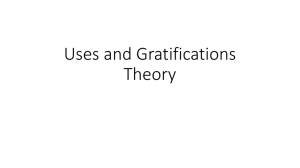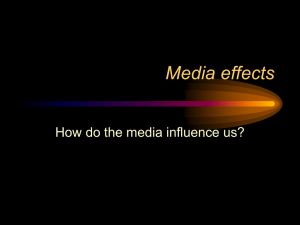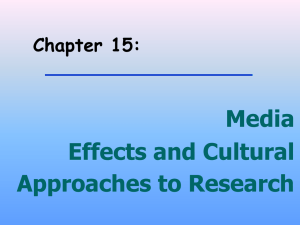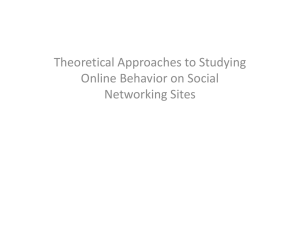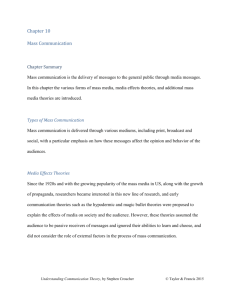Learning Intentions
advertisement
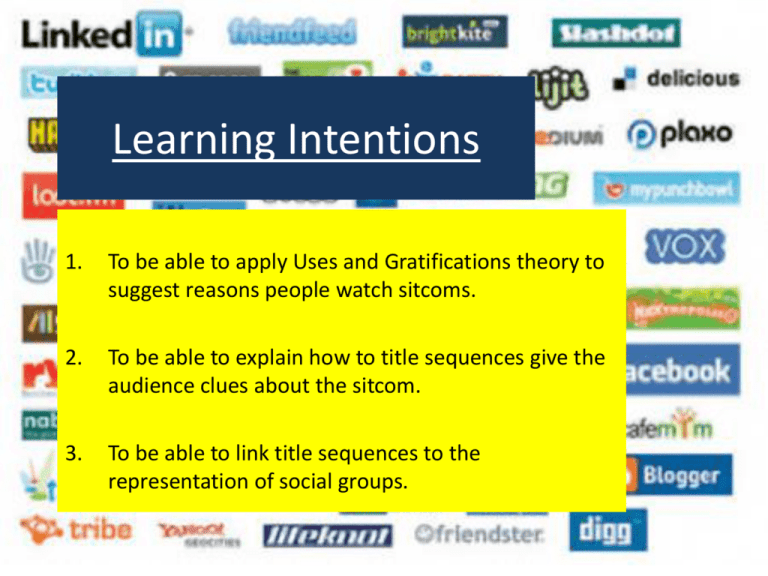
Learning Intentions 1. To be able to apply Uses and Gratifications theory to suggest reasons people watch sitcoms. 2. To be able to explain how to title sequences give the audience clues about the sitcom. 3. To be able to link title sequences to the representation of social groups. Reviewing previous learning • From last lesson, what can you tell me about mise-en-scene? • What is high key lighting and what quality does it give a show? • What is the fourth wall? What relationship does the audience have in the fourth wall set up? Building on previous learning • In today’s lesson, we will reconsider why people watch sitcoms. • We will also be looking at a number of title sequences and we will be explaining how those sequences creates and impression of the show and represents social groups. Write the statement in your book. Rate yourself between 1 to 10 on how you feel in relation to this statement. I feel confident explaining why people watch sitcoms and can link my explanation to uses and gratifications? 1 Not confident 10 Very confident Why do people watch sit-coms? • With a partner/the people around you, think of as many reasons as you can why people watch sitcoms. • You have 2 mins – you might do this as a spider diagram or a list. • Who were Blulmer and Katz? • What theory did they put forward for why people engage with the media? Blumler and Katz would have though the hypodermic needle model of media communication was rubbish. The hypodermic needle model suggested that the media sends messages to the audience and that we all accept them. Blumler and Katz, in their Uses and Gratifications theory said that people choose to engage with the media for different reasons and satisfied their individual needs. They would have said the hypodermic needle model assumed we were all the same…which we aren’t. To be able to apply Uses and Gratifications theory to suggest reasons people watch sitcoms. 1 A - Information • Developing empathy • identifying with others and gaining a sense of belonging • finding something to talk about • having a substitute for real-life friends B - Entertainment C - Personal Identity D - Integration and Social Interaction 2 Match the uses with the gratifications. In pairs – 2 minutes – be prepared to feedback! • finding reinforcement for personal values • finding models of behaviour Uses and • identifying with valued Gratifications other (in the media) • gaining insight into one's self 3 • escaping, or being diverted, from problems • relaxing • filling time • emotional release • sexual arousal 4 • finding out about relevant events and conditions in immediate surroundings, society and the world • seeking advice • general interest • learning • Security through knowledge To be able to apply Uses and Gratifications theory to suggest reasons people watch sitcoms. Information • finding out about relevant events and conditions in immediate surroundings, society and the world • seeking advice • general interest • learning • Security through knowledge Entertainment Personal Identity • finding reinforcement for personal values • finding models of behaviour • identifying with valued other (in the media) • gaining insight into one's self Uses and Gratifications • escaping, or being diverted, from problems • relaxing • filling time • emotional release • sexual arousal Integration and Social Interaction • Developing empathy • identifying with others and gaining a sense of belonging • finding something to talk about • having a substitute for real-life friends Why would the consumer “use” this media – how many of the “gratifications” does it offer? 1. Information 3. Social integration 2. Personal identity 4. Entertainment. Look back to the spider diagram/ list you made at the beginning of the lesson – do any of the reasons link to uses and gratifications theory? Which reasons? Why? Mini-plenary I feel confident explaining why people watch sitcoms and can link my explanation to uses and gratifications? 1 Not confident 10 Very confident Learning Intention To be able to apply Uses and Gratifications theory to suggest reasons people watch sitcoms. 2. To be able to explain how to title sequences give the audience clues about the sitcom. • We are going to look at the Friends opening sequence. • As we watch it for the first and second time, be prepared to think about and feedback the following: • What does the mise-en-scene (the things in the scene) tell us about the SITUATION of the comedy. What impressions does it give us? • You must use examples from the clip – avoid generalisations. Choose 3 examples… • Focussing on the mise-en-scene, what does the opening title sequence to friends tell us about what the show will be about/ the SITUATION of the show? Be specific with examples… Quick recap – this is an ESTABLISHING SHOT. What does an establishing shot do? • We are going to watch the clip again. This time I would like you to think about the sound that is used. • But wait…what key media language do you need to know in order to analyse the sound? Diegetic sound : sound that exists and that the characters could hear Non-diegetic sound : sound that only the audience hears Synchronous sound: sound that matches what you see on screen Asynchronous sound: sound that doesn’t match Think about the sound in this opening. How does the sound (and the lyrics especially) create a set of expectations for the audience? Stick a pony in me pocket, I'll fetch the suitcase from the van, Cause if you want the best 'uns And you don't ask questions Then brother I'm your man Where it all comes from Is a mystery It's like the changing of the seasons And the tides of the sea But heres the one thats driving me berserk Why do only fools and horses work 15-minute AFL activity • Find out how much you have learnt. • Choose either the Friends opening sequence or the Only Fools and Horses opening sequence. 1. (10 mins) How does the opening sequence for your chosen sitcom create clues about the situation of the show? Consider mise-en-scene and sound in your answer. 2. (5 mins) How does the sitcom gratify the user (i.e. entertainment, information, social integration, personal identity)? …..gratifies the user by offering them….. For example, in the show… Stretch activity • Imagine you have just been commissioned to create your own new sitcom. • What would your opening sequence be like? Think particuarly of mise en scene and sound. • Describe/draw, shot-by-shot, your opening sequence and explain your choices. 3. To be able to link title sequences to the representation of social groups. Key information REPRESENTATION – how people are made to look SOCIAL GROUPS – different “types” of people; e.g. “chavs” different races, different ages Look again at the clip from The Inbetweeners. Which social groups are being represented and how are they being made to look. Think about the mise-en-scene (the way they walk, look, where they are etc) and the way they sound? Key information REPRESENTATION – how people are made to look SOCIAL GROUPS – different “types” of people; e.g. “chavs” different races, different ages Look again at the clip from The Inbetweeners. Which social groups are being represented and how are they being made to look. Think about the mise-en-scene (the way they walk, look, where they are etc) and the way they sound? Have we succeeded in meeting our Learning Intentions? 1. To be able to apply Uses and Gratifications theory to suggest reasons people watch sitcoms. 2. To be able to explain how to title sequences give the audience clues about the sitcom. 3. To be able to link title sequences to the representation of social groups.
